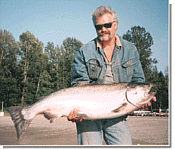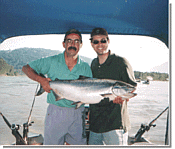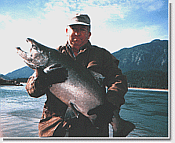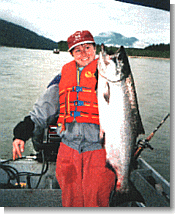Early Chinook Fishing
Early Chinook Fishing
By Vic Carrao
The Fraser River offers some good opportunities for early Chinook Salmon. The Fraser River Chinook runs begin as early as March but the river normally does not open until May 1st. By all early indications the Fraser should open for retention of Chinook on May 1st /2002.
 There are several methods used to catch early Chinook on the Fraser and creek mouths. First I would like to talk about fishing the main stem of the Fraser. The most popular method used for Chinook Salmon is bar fishing from shore or plunking from a boat. Bar fishing is probably the most social fishing you'll ever do, the only real requirements are a lawn chair, umbrella for rain or sun, a phermos full of coffee and a good attitude. Once you've participated in this fishery you'll soon become part of a larger family, the Fraser River family. The people who frequent the banks on the Fraser are in most part great people, you just need to use a little common sense when your looking for an area to place your rod. Giving other anglers plenty of room will ensure an enjoyable day without confrontation.
There are several methods used to catch early Chinook on the Fraser and creek mouths. First I would like to talk about fishing the main stem of the Fraser. The most popular method used for Chinook Salmon is bar fishing from shore or plunking from a boat. Bar fishing is probably the most social fishing you'll ever do, the only real requirements are a lawn chair, umbrella for rain or sun, a phermos full of coffee and a good attitude. Once you've participated in this fishery you'll soon become part of a larger family, the Fraser River family. The people who frequent the banks on the Fraser are in most part great people, you just need to use a little common sense when your looking for an area to place your rod. Giving other anglers plenty of room will ensure an enjoyable day without confrontation.
Equipment used for bar fishing consists of a medium to medium heavy rod, 10 to 12 ft with a line rating of 12-30lb's capable of casting up to 20 oz of lead. There are two types of rods primarily used, a large spin cast /surf rod or heavy bait cast rod. Some of the more common spincast rods are the shimano 12 ft surf rods and the 11 to 13 ft Shakespeare Ugly stick. For those who prefer a level wind with a baitcast rod I would recommend the 11ft Abu Garcia Concord or the 11ft Trophy Fraser River King. Reels should be capable of holding a minimum of 200yds of 25lb test, the Abu Garcia 7000 is very nice and the new Abu Morrum 7700 is a gem. Penn also makes a nice reel which is very affordable, the Penn 320 or 321(left hand) is durable and can be used for sturgeon as well.
 The need for strong durable equipment is related directly to the method and species of fish. Chinook Salmon are the strongest of the salmon family, they can reach up to 50 lbs plus and don't take being hooked very lightly. On many occasions these Chrome beauties will take off like a freight train bound for the ocean, this is one of the reasons for strong rods and reels that can handle plenty of line not to mention casting heavy lead.
The need for strong durable equipment is related directly to the method and species of fish. Chinook Salmon are the strongest of the salmon family, they can reach up to 50 lbs plus and don't take being hooked very lightly. On many occasions these Chrome beauties will take off like a freight train bound for the ocean, this is one of the reasons for strong rods and reels that can handle plenty of line not to mention casting heavy lead.
The standard set up requires very little tackle, most anglers prefer to use a 6 or 8 inch spreader bar attached to the mainline, a piece of 6 inch mono tied to the bottom with a snap swivel to hook on the lead. Attached to the 6 or 8 inch spreader bar is a leader of 36 to 40 inches with a # 2, #0, or #00 spin n glo. The amount of lead used is directly related to depth and current of the area being fished, this is where having the appropriate equipment comes into play. If anglers around you are using 18 to 20 oz of lead to hold their lure in the determined slot or travel area of the fish, then you must use the same amount of lead in order to keep from tangling up all the lines. If you were to use 12 oz in this situation your lead would not hold and would walk down the river tangling with other anglers. Once you've cast the lure out into the river, just set your rod into a rod holder and wait.
 Rod holder's come in many shapes & sizes, I've found the better ones are usually made by the angler himself or by someone they know who has access to cheap material and a welding machine. The only real requirement is that the rod holder shaft be long enough to spike into the gravel a couple of feet and still have enough shaft to keep the rod clear above the water. I prefer a 4 ft shaft with a 1 ft tube to hold the rod. Many anglers attach a cow bell to the rod so that when a fish hits the bell rings. It can drive you nuts trying to watch your rod tip all day not to mention the sore neck. Attaching a bell will allow you some freedom to move around the area while still be aware if a fish grabs your lure. It makes for a great day with the family when you can throw your lines out, then go on an adventure with your kids. My girls love to hunt for agates and jade and go for hikes into the wooded areas.
Rod holder's come in many shapes & sizes, I've found the better ones are usually made by the angler himself or by someone they know who has access to cheap material and a welding machine. The only real requirement is that the rod holder shaft be long enough to spike into the gravel a couple of feet and still have enough shaft to keep the rod clear above the water. I prefer a 4 ft shaft with a 1 ft tube to hold the rod. Many anglers attach a cow bell to the rod so that when a fish hits the bell rings. It can drive you nuts trying to watch your rod tip all day not to mention the sore neck. Attaching a bell will allow you some freedom to move around the area while still be aware if a fish grabs your lure. It makes for a great day with the family when you can throw your lines out, then go on an adventure with your kids. My girls love to hunt for agates and jade and go for hikes into the wooded areas.
Plunking
Plunking from the boat is much the same as bar fishing. The rods can be a bit lighter than a shore rod as you don't need to cast as far. Finding an area to anchor your boat can be half the challenge. Many area's that we anchor are fast flowing, having the proper anchor will ensure you don't disrupt other anglers. I've seen many occasions when a boater will try to anchor out in front of a bar that has shore anglers only to get yelled at and lead casted at their boats. I would recommend anchoring in area's that have no shoreline or no shore anglers in order to avoid a confrontation or personal injury.
Casting and Trolling
 Another productive method to catch Fraser River Chinook is casting or trolling lures in the creek mouths located up and down the Fraser River basin. Casting lures is one of the more popular methods for fishing these creek mouths. One of the more productive lures used is the Gibbs Kitimat & Gibbs Koho spoons in sizes # 45 & # 55. Most tributary rivers that flow into the Fraser will have a pool or deep section at the confluence. The water flowing from the tributaries are usually clearer which make a great place for salmon to rest and clean out their gills from silt retained from the migration up the Fraser. Another productive method to catch Fraser River Chinook is casting or trolling lures in the creek mouths located up and down the Fraser River basin. Casting lures is one of the more popular methods for fishing these creek mouths. One of the more productive lures used is the Gibbs Kitimat & Gibbs Koho spoons in sizes # 45 & # 55. Most tributary rivers that flow into the Fraser will have a pool or deep section at the confluence. The water flowing from the tributaries are usually clearer which make a great place for salmon to rest and clean out their gills from silt retained from the migration up the Fraser.
I prefer to cast the Gibbs Kit-A-Mat's or Koho spoons over float fishing as it's much more effective for covering deeper and larger bodies of water. Locate the area where the deeper water begins, cast your lure to that point and allow it to sink to the bottom, then begin retrieving the lure with a slow consistent retrieve across the current. Each cast should be 1 to 2 feet further towards the back of the run, pool or slot, remember to use the current to your advantage by allowing the lure to sink. If your fishing fast water the current will add action to your lure so you may want to slow the retrieve even more.
One distinct Chinook fishery in the Fraser Valley is the confluence of the Sumas Canal. This area is heavily fished by anglers using several methods. Casting, Trolling and plunking are 3 of the most productive methods. The Sumas Canal meets the Fraser Rivers main flow approximately 5 miles above Mission. The Vedder River which flows into the Sumas is a clear water river. The Fraser is usually colored and silted during the spring freshet. Where these to rivers meet can be a productive place to catch Chinook which makes for a great place for fish to hold and clean their gills. The south shoreline of the canal clear water meets the silted water of the Fraser. This is where you want to fish if your plunking or trolling lures, many anglers will also cast and troll the lures in the canal itself.
The most productive lures used in this area are the Gibbs Kit-A- Mat and Koho spoons in sizes #45, 55 & 65. The size of lure will vary depending on whether your casting or trolling. The depth is only 5 to 10 feet so retrieve or troll speed will determine size of lure. The #45 Kit-A-Mat is 1 7/8 inch 3/8oz, #55 is 2 3/8 inch 7/8oz and the #65 is 2 5/8 inch 1 oz. The Koho comes in a variety of sizes and shapes as well, #35 -1 7/8 in 3/8oz, #45 - 2 inch 5/8oz, #55 - 2 3/8ich 3/4 oz and the #65 - 2 7/8 1 oz. I would recommend carrying a variety of colors in the #35 to #55 for casting and #45 to #65 for trolling in either a Kit-A-Mat or Koho spoon. Another popular lure for trolling is the Gibbs Tee Spoon, they come in blade lengths from 1 in to 3 1/4 inch. These are very nice for trolling the shallower area's as they have little weight and will snag on bottom less often. Many of the old timers who only troll use nothing but a Tee Spoon which tells you something.
The Fraser River is one of the few places left that still have plenty of fishing opportunities, "we need to keep it that way". The political pressure place on DFO to limit fishing opportunities for the average British Columbian is over whelming. There are many fishing organizations that defend your right to fish, joining one of these groups will help insure your voice is heard.
|
